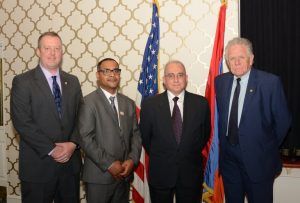Current state of the Armenian monastery in Alevkayasi

The Saint Makar Armenian Monastery of Alevkayasi is being destroyed instead of being open for tourists. The monastery, which has been left unattended for years, is in a very poor condition…No action has been taken to preserve the monastery, and as a result, it has been destroyed inside and outside, and some parts of the monastery are on the verge of collapse. Years ago, some rooms were given for rent. Today, one can see the traces of the violence.
Years ago, it had been given for rent for purpose of tourism
In 1997, by the decision of the Council of Ministers, the monastery was granted to Dervish Sionmez for a period of 49 years, but in 2005, it was decided to annul the agreement.
Since 2005, the monastery has been abandoned. The corresponding bodies aren’t doing anything to open the doors for tourists.
Like many other historic monuments, this monastery has been left to the whim of fate.
The Saint Makar Armenian Monastery of Alevkayasi
The Saint Makar Monastery, which is located in the Plataniotsa Forest of Alevkayasi and is also known as Makaravank Monastery, was built in honor of Saint Makarios (306-395), who was a hermit in Alexandria. According to tradition, since this saint had lived as a hermit in nearby caves for a while, celebrations are held in his honor at Saint Makar Monastery on the day of his remembrance (first Sunday of May). The monastery was built in approximately the 9th century by a small group of Christian Egyptians of Cyprus, that is, the Ghptis. In 1425, the monastery went under the jurisdiction of the Armenian Church. For years, the monastery has served as the major place of worship for the Armenians of Syria, Lebanon, Armenia and Cyprus. In the Ottoman era (1571-1878), it was remembered as the “Blue Monastery” for the color of its door and windows. In 1642, the Ottoman government secretly granted the right of ownership of the monastery to the Armenian Church. Between 1660 and 1701, the right of ownership was reestablished, and the monastery was exempt from taxes. It’s safe to say that the years between 1650 and 1750 were the golden age of the monastery. The monastery is located at an altitude of nearly 530 meters above sea level with an 8,500-9,000 dyonyum land parcel that stretches to the sea and in which a 1 km long coast is included. Prior to 1974, the Armenian episcopate used to receive 8,000 Cypriot Liras a year from the olive trees that would grow on this land parcel.
The monastery has been renovated between 1734 and 1735, in 1814 and between 1947 and 1949. In 1814, a church was built in the yard, and in 1926-a belfry. There was a time when numerous historic, religious and national manuscripts were kept here, the oldest of which dated back to 1202, and the newest-to 1740. In 1947, 56 of the manuscripts were taken to the Catholic House of Cilicia locate in Antelias, Lebanon.
The monastery has been a place where Catholic patriarchs and priests of Cilicia would spend their summers to rest and recover. Besides them, some Armenian families of Cyprus would also come here to rest and enjoy their summer vacation. The students of Melkonian School and Armenian scouts would set up tents near the monastery. On St. Makarios Day (first Sunday of May), the monastery would become the place for almost all Armenians to gather. On that day, people would prepare the Armenian harisa dish and treat all the gathered. Although there were fewer pilgrimages to the monastery after 1974, a large flow of pilgrims started visiting the monastery in 2007.
(Tuncer Bagishkan, Adres magazine)
http://www.yeniduzen.com/
Translated from Turkish into Armenian by Anahit Kartashian
Akunq.net




 Արևելահայերեն
Արևելահայերեն Արևմտահայերեն
Արևմտահայերեն Русский
Русский






